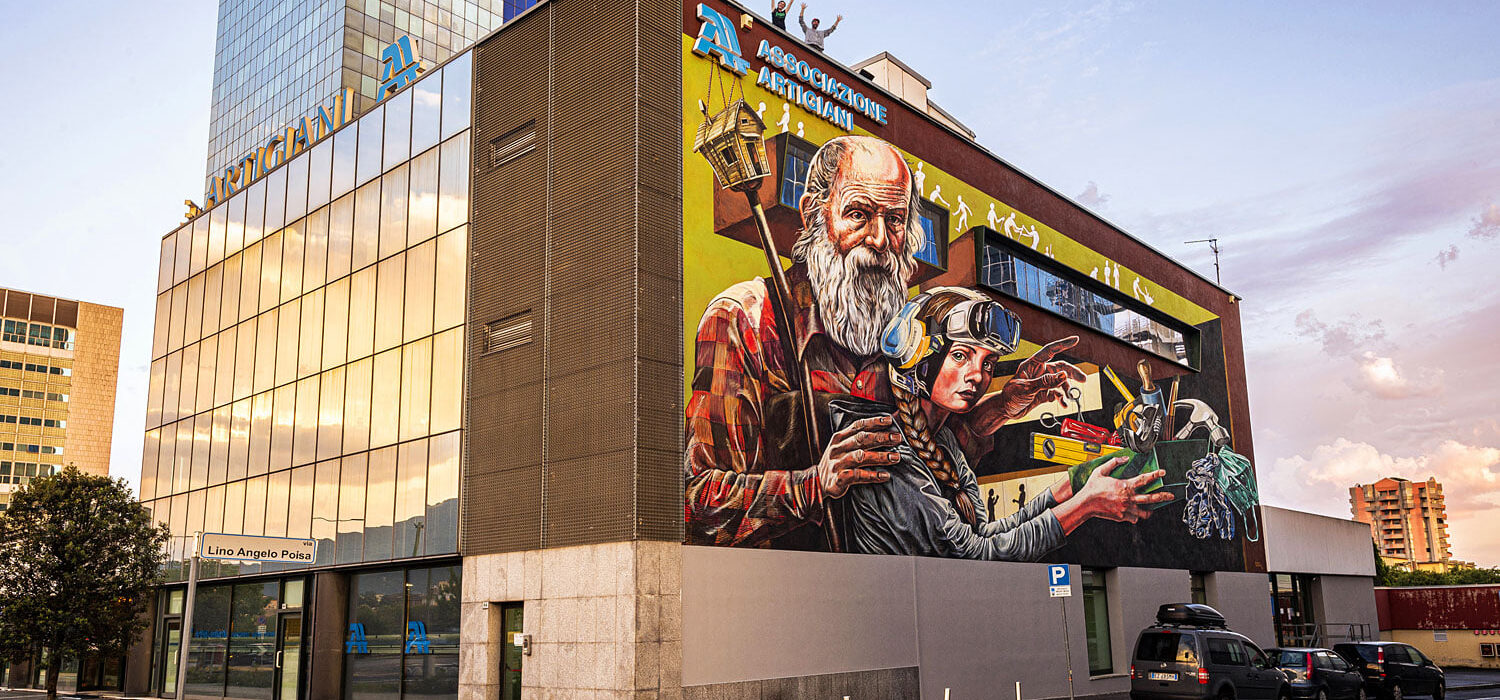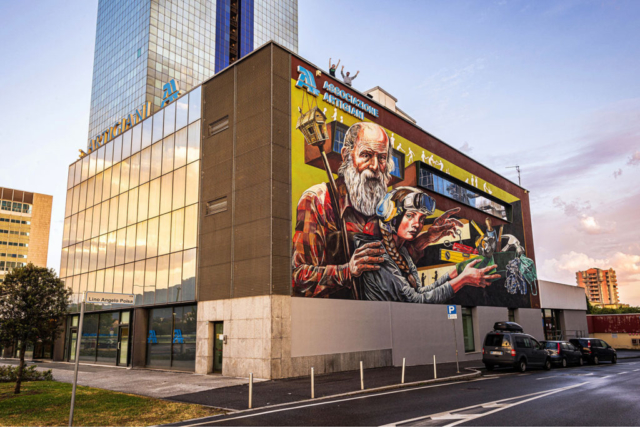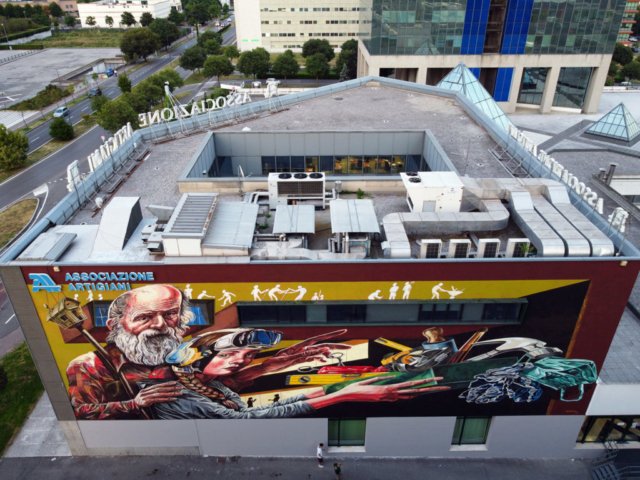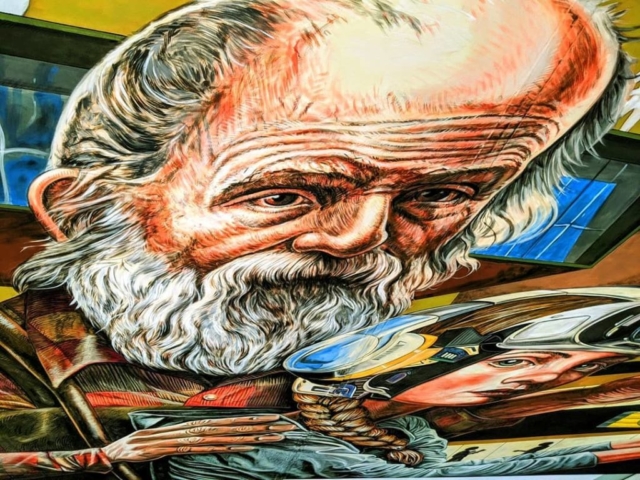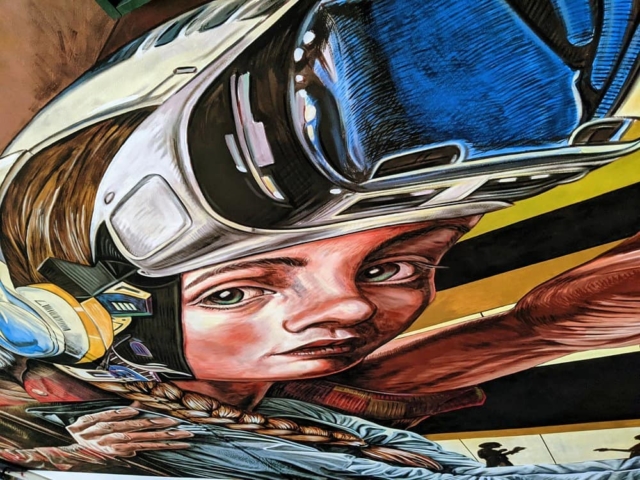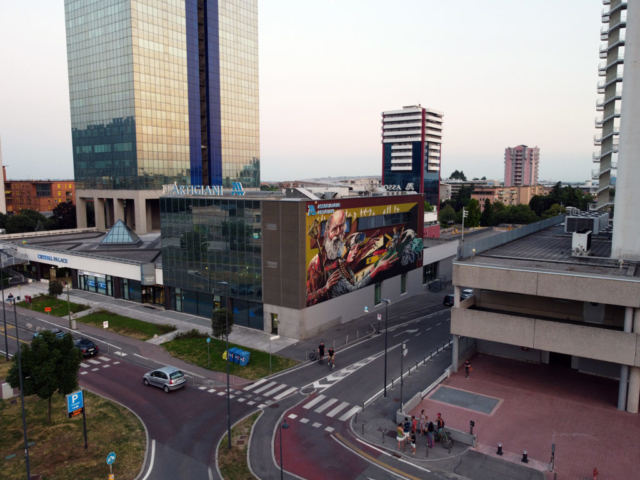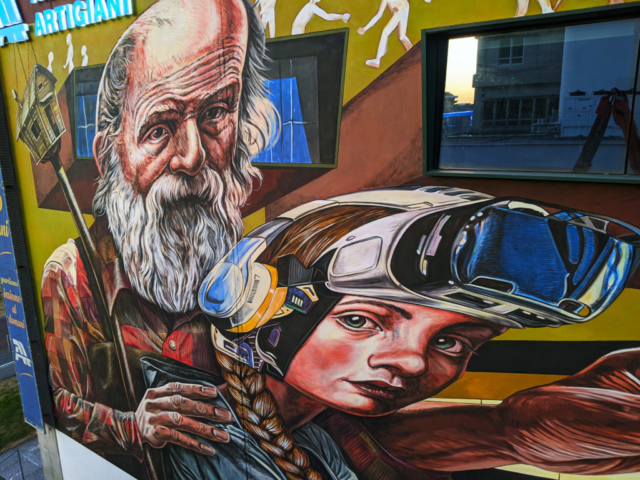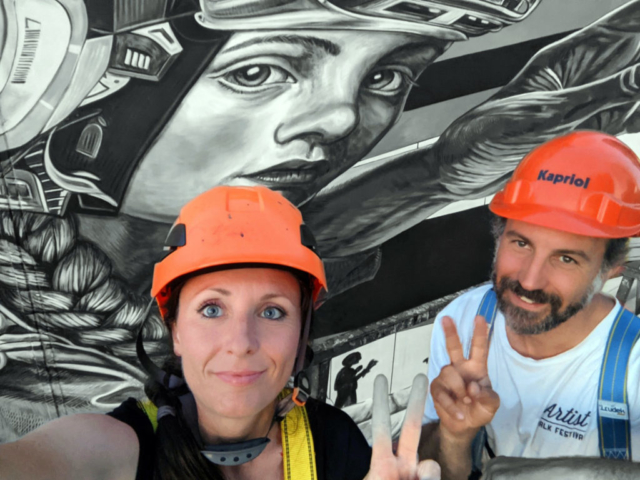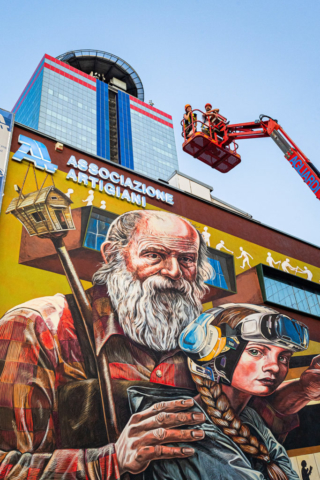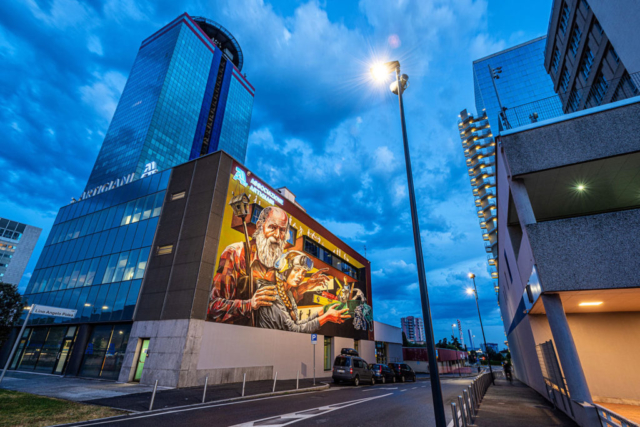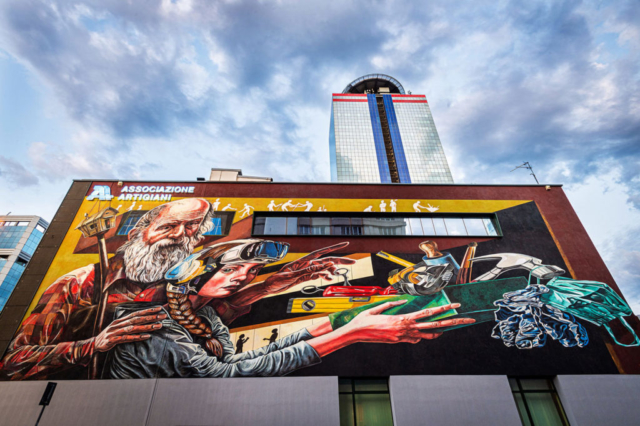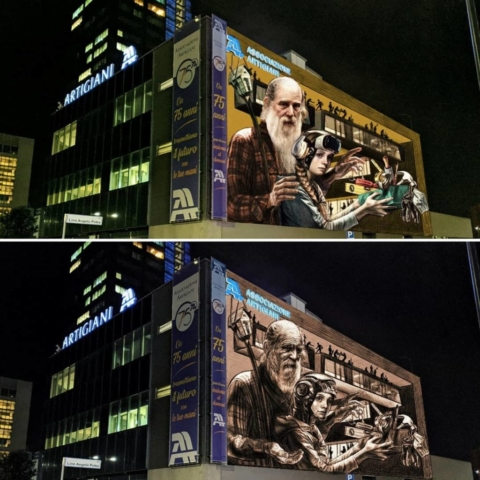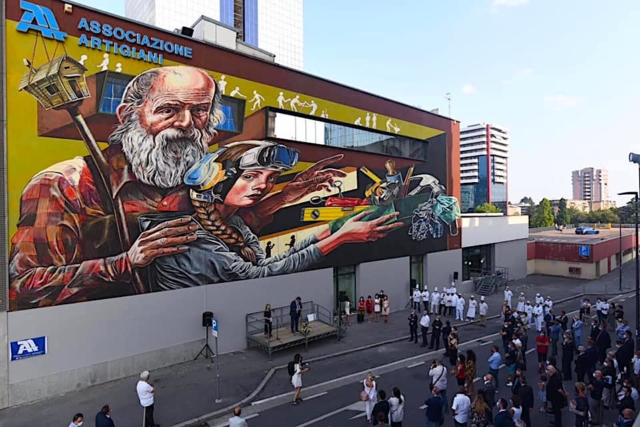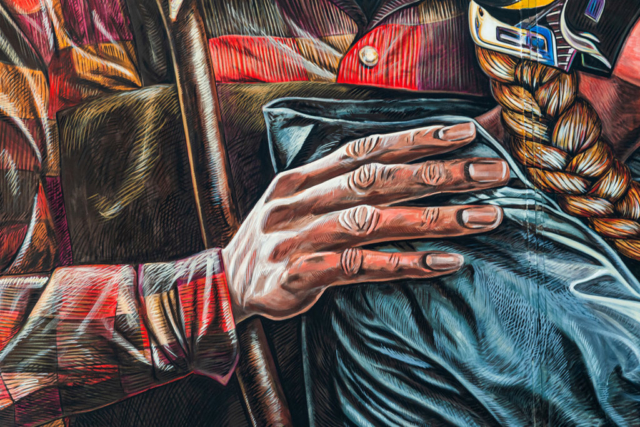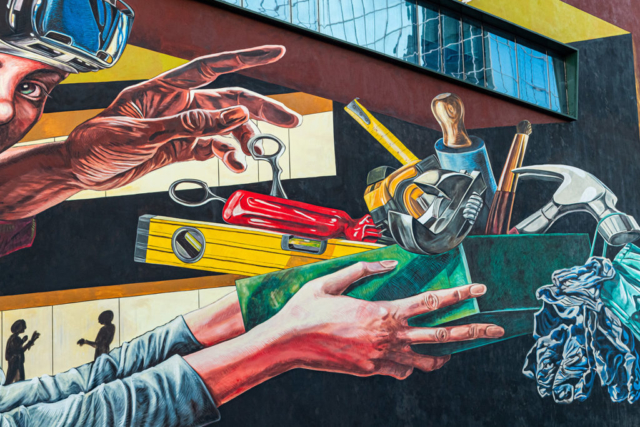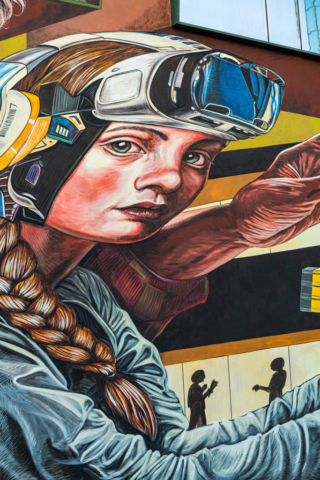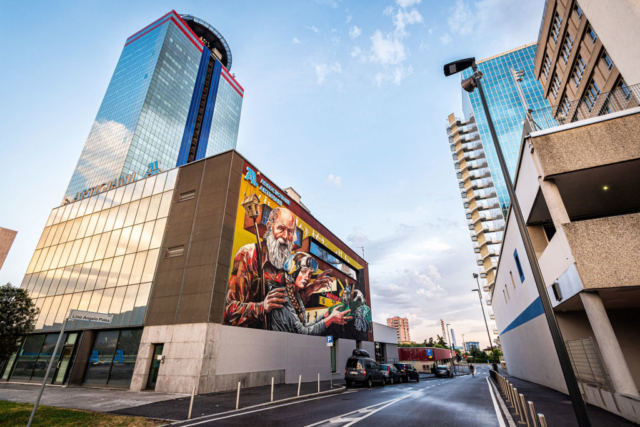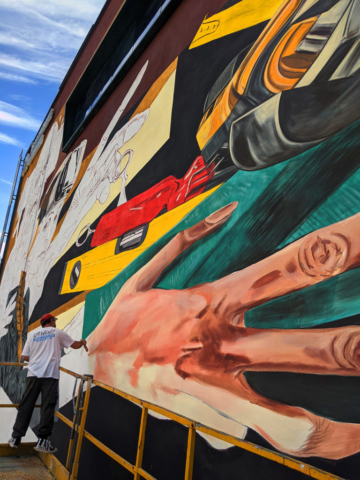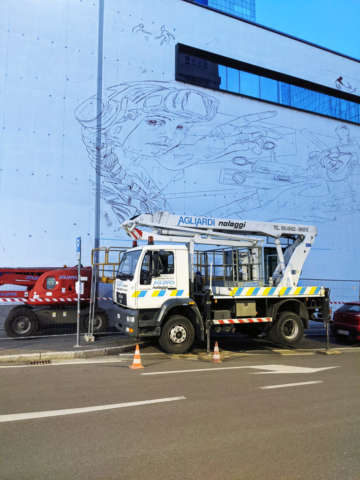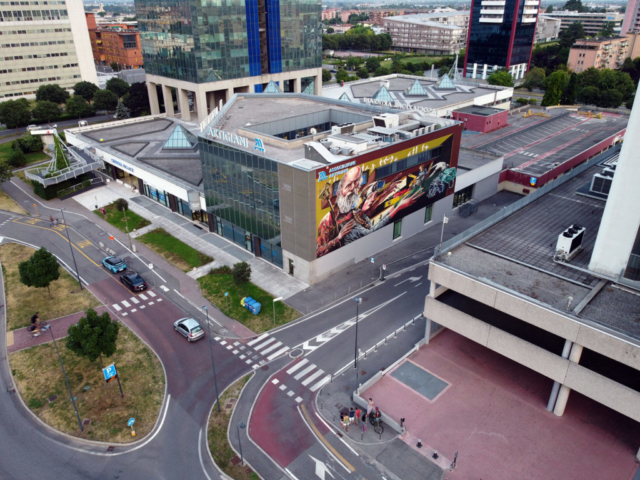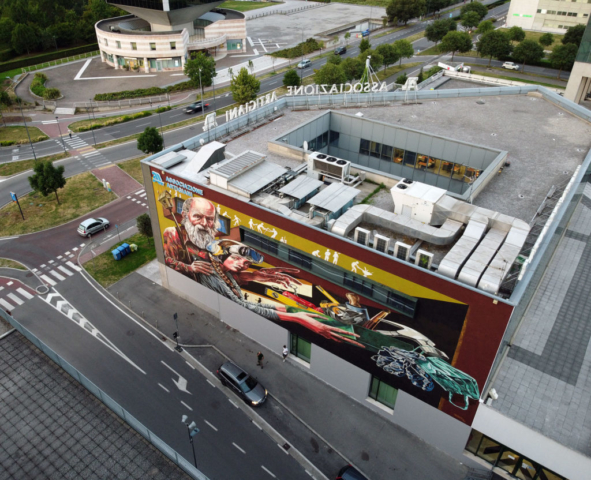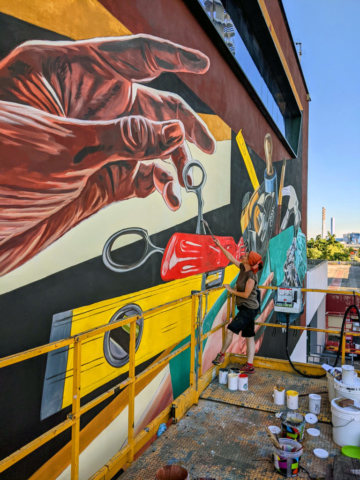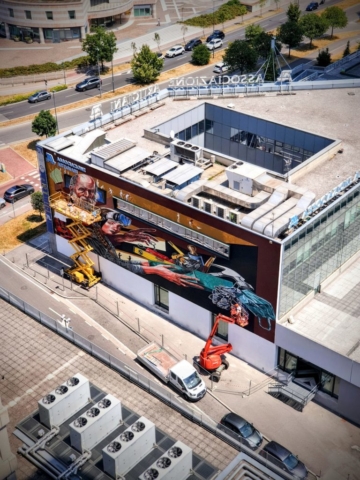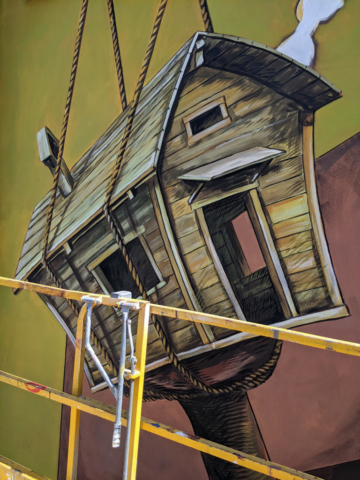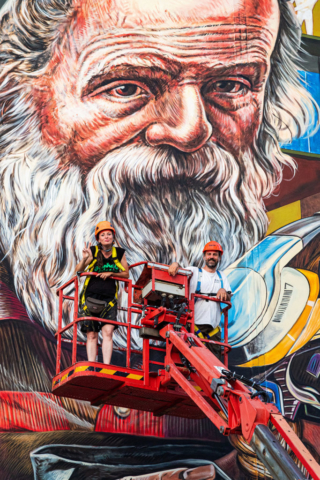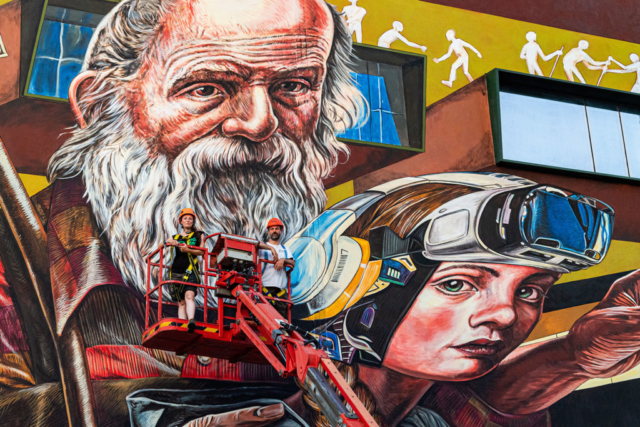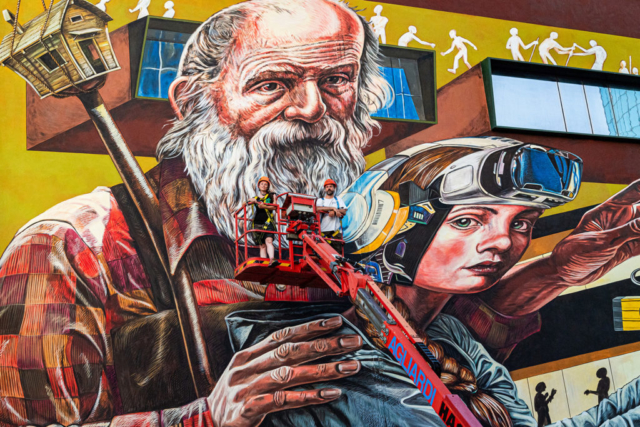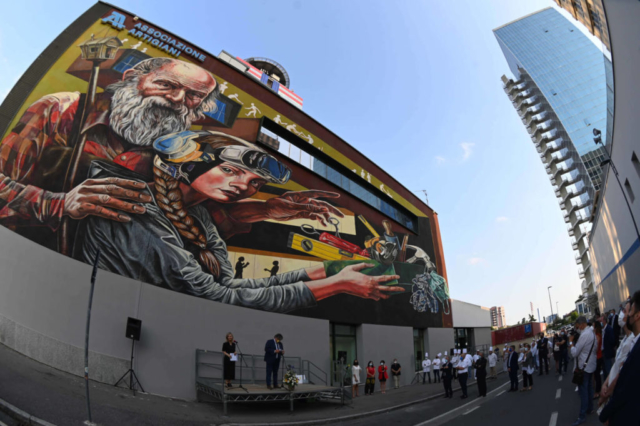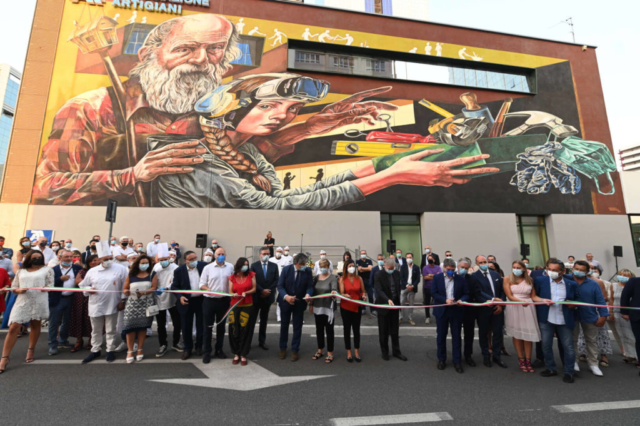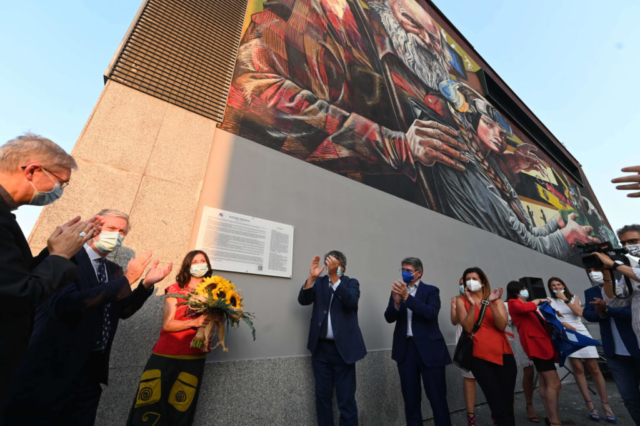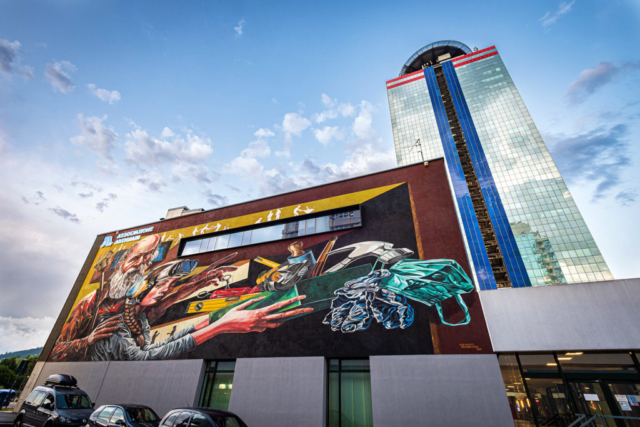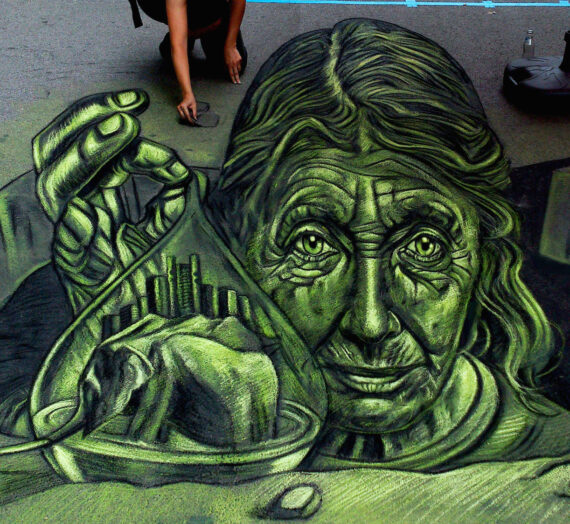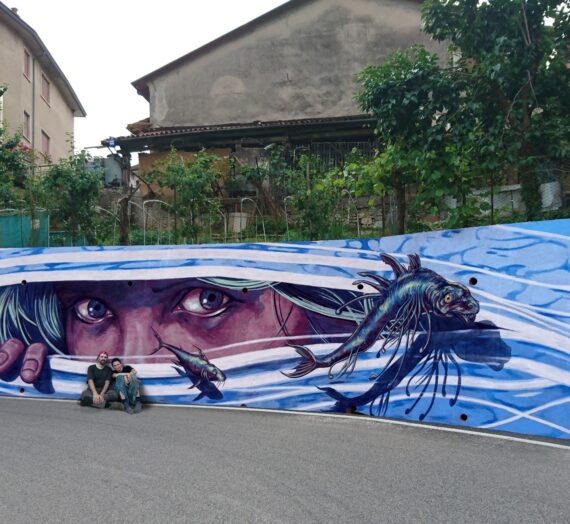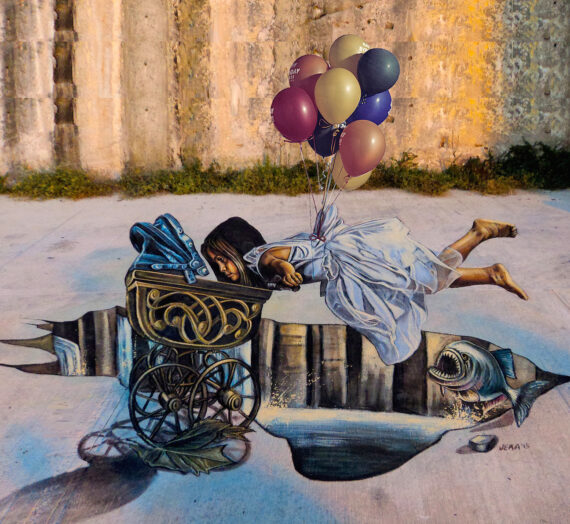“Futura traditio nasce da una contaminazione fra il mio immaginario artistico e il mondo articolato raccontatomi dagli artigiani. Il tema è quello del complesso rapporto fra tradizione e innovazione, concetti non antitetici da pensare in necessaria coesistenza, rivalutando ciò che spesso consideriamo alterità. La fruizione stessa dell’opera, in accentuato anamorfismo, presuppone la ricerca di un punto di vista diverso, inusuale, inatteso.”
Questo è ciò che scrissi in un flash, a luglio, per presentare l’anamorfosi* di Bresciadue, probabilmente una fra le più grandi realizzate con questa tecnica a livello nazionale (320 m2), opera creata con Fabio Fedele per l’Associazione Artigiani e da loro donata simbolicamente alla città.
Un pezzo in prospettiva quindi, che inserisce due enormi personaggi in una cornice architettonica, in modo da dare l’impressione che facciano capolino attraverso una sorta di stanza virtuale. Dentro questa scatola un finestrone illusorio imita il serramento vero, reso tridimensionale e fluttuante.
Il dipinto deve essere fotografato da un punto di vista laterale, indicato a terra, ma per rendersi pienamente conto della deformazione del disegno è necessario camminare lungo la via, fino alla fine del dipinto, lungo 30 metri.
Ci sono voluti 16 giorni, in due, con una media di 14 ore al giorno sulle piattaforme aeree. Una giornata solo per tracciare quadrettatura e linee di fuga, verificandone da terra le direzioni.
Se la realizzazione si è rivelata tecnicamente complessa, forse ancor più complicata è stata la genesi del progetto. È arrivato perciò il momento di raccontarvi del significato dell’opera. Non voglio annoiarvi con la gestazione delle bozze, preferisco concentrarmi sulla versione finale e parlare di simboli.
Il titolo è una sorta di ossimoro che affianca il concetto di tradizione (tramandata) all’idea di futuro come parte di tempo che non ha avuto luogo ed è quindi inconoscibile. Si parla quindi di una tradizione intesa come in ambito filosofico, dinamica e attiva lungo le generazioni.
Due personaggi a simboleggiare tradizione e innovazione, con differenti competenze e risorse, volutamente molto diversificati per età.
L’uomo anziano in abito da lavoro rappresenta l’artigiano come da immaginario collettivo, il maestro di bottega che tramanda antica conoscenza, la manualità, l’abilità tecnica. Le sue mani rugose in vista simboleggiano due diversi atteggiamenti. La sinistra è in azione, indica, crea, ricorda (si pensi alla posizione delle mani nella creazione di Adamo di Michelangelo). La destra, si appoggia sulla spalla della ragazza in segno di protezione e di fiducia.
La giovane donna che indossa un copricapo futuristico con visore e cuffie raffigura l’artigianato 4.0, nato dalle tecnologie della quarta rivoluzione industriale. Si pensi come robot, stampanti 3D, lasercut e digitale stanno cambiando il modo di progettare e fabbricare gli oggetti. Le sue mani reggono una scatola dalla quale fuoriescono attrezzi legati al mondo artigiano.
Entrambi rivolgono lo sguardo all’osservatore, lo richiamano dalla strada, la ragazza è diretta, sicura di sé, l’uomo è pensieroso. Sono in una particolare relazione, come se uno proteggesse l’altra, ad indicare continuità e mutua assistenza ma anche la sostenibilità dei relativi progetti (si pensi all’iconografia del figliol prodigo e alle matrioske, una inseribile nell’altra).
La trasmissione dei saperi si coglie nel passaggio della scatola. La giovane l’ha ricevuta e si volge per porgerla agli artigiani del futuro, rappresentati in silhouette nera nella luce proveniente da una delle finestre virtuali. Si affacciano quasi evanescenti ma non è ancora noto il loro ruolo, resta un punto aperto. A mio parere si tornerà alla manualità, al pezzo unico, ma non è dato sapere. Mi sono resa conto, a lavoro concluso, che i personaggi paiono indossare dei guanti animati simili a dei volti di animali. Inconsciamente sono finiti lì e mi ricordano le storie raccontate nei fienili, orecchie tese di bambini stupiti.
Un brulichio di figure bianche si nota poi sopra la finestra in alto a destra (la finestra reale dell’edificio) e anche sulla sua ideale prosecuzione (fittizia) a sinistra, fino a raggiungere la metaforica “casa” che dal bastone si collega alla “A” della scritta luminosa. Sono le ombre (luminose in quanto significanti) dei lavoratori del passato.
La casa posta a guisa di lanterna sulla sommità del bastone rimanda all’iconografia del pellegrino sostituendo la conchiglia e la zucca svuotata con l’idea di luogo sicuro, di accoglienza, di dialogo. A reggerla è il maestro di bottega, depositario della tradizione e del diffondersi delle tecniche nel mondo.
L’opera doveva essere realizzata nella primavera del 2020. Poi il progetto è slittato di oltre un anno, sia per questioni burocratiche (relativamente alle quali preferisco sorvolare), che per gli ovvi motivi che tutti conosciamo, a causa di una pandemia globale che a Brescia ha lasciato decisamente il segno.
Ne è derivata una modifica della bozza (chi mi conosce sa che non apporto cambiamenti ai bozzetti su richiesta, ma stavolta è stato diverso). Ho riflettuto, su richiesta degli artigiani, su come poter sfiorare il tema del Covid-19 senza rendere il pezzo drammatico, cosa non facile a livello iconografico.
Dalla scatola degli attrezzi emergono una mascherina e un paio di guanti sgualciti. Abbiamo superato la fase più acuta della pandemia anche attraverso opere di solidarietà e pertanto questi elementi sono in dotazione nel kit dei saperi/strumenti (sono comunque dispositivi usati durante alcune fasi di lavoro in diversi ambiti). Non sono però inseriti pienamente nella scatola, penzolano appesi ad un martello. Volutamente non li hanno inchiodati al muro. Il martello è a disposizione per farlo ma sappiamo che il rischio è sempre presente e che forse questa brutta esperienza non è chiusa (o che potrebbe ripetersi, in altre forme).
A livello simbolico ho perciò voluto giocare ancora con la prospettiva. Se infatti il tema della pandemia è solo evocato fotografando l’opera dal punto di vista corretto, lo stesso diviene via via più significativo avvicinandosi al lato destro del dipinto, dove ci si rende conto di come lo spazio occupato da mascherina e guanti sia di grande metratura.
Speranza quindi, ma anche un monito alla cautela.
Non vorrei tediarvi con un racconto più lungo perché pare che all’inaugurazione del 22 luglio, nonostante l’ansia da prestazione e il gesticolare frenetico seriale, io abbia parlato per oltre otto minuti!
Aggiungo solo una postilla, per gli affezionati di Fabio. Vi chiederete perché il mitico (fedele e paziente) Fabio abbia nuovamente accettato di aiutarmi dopo l’esperienza di digiuno in cava. Che sia anche autolesionista? Sappiate che questa volta è stato rifocillato alla grande, anche se a orari assurdi, ma non si può avere tutto, suvvia. Grazie, amico mio!
Ringrazio ancora Assoartigiani e tutti coloro che hanno contribuito al progetto, il Comune di Brescia, Nicoletta Bontempi, Andrea Zampatti (fotografie finali dell’opera), Alessandra Dosselli – Almainfinita Studio (video del making off, che trovate di seguito), Matteo Rinaldi (riprese col drone).
Un grazie speciale a Paolo Carrera, per la grande attenzione e l’affetto.
*anamorfòṡi s. f. [dal gr. ἀναμόρϕωσις «riformazione», der. di ἀναμορϕόω «formare di nuovo»] rappresentazione pittorica realizzata secondo una deformazione prospettica che ne consente la giusta visione da un unico punto di vista (risultando invece deformata e incomprensibile se osservata da altre posizioni). Il termine appare nel XVII secolo per indicare le «depravazioni ottiche» fondate sui giochi della riflessione e della prospettiva. La conoscenza dei procedimenti per costruirle fu a lungo trasmessa come dottrina magica e segreta, invadendo poi i trattati di prospettiva e le speculazioni ottiche seicentesche, fino ad esplodere nell’opera di due grandi gesuiti, Kircher e Bettini. (Jurgis Baltrušaitis, Anamorfosi o Thaumaturgus Opticus, Adelphi 1978).
(In English now!)
“Futura traditio was born from a contamination between my artistic imagination and the articulated world told to me by the artisans. The theme is that of the complex relationship between tradition and innovation, non-antithetical concepts to be thought of in necessary coexistence, re-evaluating what we often consider otherness. The very fruition of the work, in accentuated anamorphism, presupposes the search for a different, unusual, unexpected point of view.”
This is what I wrote in a flash, in July, to present the anamorphosis of Bresciadue, probably one of the largest made with this technique at national level (320 m2), a work created with Fabio Fedele for the Artisans Association and symbolically donated by them to the city.
A piece in perspective then, which inserts two huge characters in an architectural frame, in order to give the impression that they peep through a sort of virtual room. Inside this box an illusory window imitates the real window, made three-dimensional and floating.
The painting must be photographed from a lateral point of view, indicated on the ground, but to fully realize the deformation of the drawing it is necessary to walk along the street, to the end of the painting, 30 meters long.
It took 16 days, in two, with an average of 14 hours a day on aerial platforms. A day just to draw squares and escape lines, checking their directions from the ground.
If the realization turned out to be technically complex, perhaps even more complicated was the genesis of the project. The time has therefore come to tell you about the meaning of the work.
I don’t want to bore you with the gestation of drafts, I prefer to focus on the final version and talk about symbols.
The title is a sort of oxymoron that combines the concept of tradition (handed down) with the idea of the future as part of time that has not taken place and is therefore unrecoal. We therefore speak of a tradition understood as in the philosophical field, dynamic and active throughout the generations.
Two characters to symbolize tradition and innovation, with different skills and resources, deliberately very diverse by age.
The old man in work clothes represents the craftsman as per the collective imagination, the master of the workshop who handed down ancient knowledge, manual skills, technical ability. His wrinkled hands in sight symbolize two different attitudes. The left is in action, it indicates, creates, remembers (think of the position of the hands in Michelangelo’s creation of Adam). The right rests on the shoulder of the girl as a sign of protection and trust.
The young woman wearing a futuristic headdress with a viewer and headphones depicts 4.0 craftsmanship, born from the technologies of the fourth industrial revolution. Think how robots, 3D printers, lasercuts and digital are changing the way we design and manufacture objects. His hands hold a box from which come out tools related to the artisan world.
Both turn their gaze to the observer, call him back from the street, the girl is direct, self-confident, the man is thoughtful. They are in a particular relationship, as if one were protecting the other, to indicate continuity and mutual assistance but also the sustainability of the related projects (think of the iconography of the prodigal son and the matryoshkas, one insertable in the other).
The transmission of knowledge is captured in the passage of the box. The young woman has received it and turns to offer it to the artisans of the future, represented in a black silhouette in the light coming from one of the virtual windows. They face almost evanescent but their role is not yet known, it remains an open point. In my opinion we will return to manual skills, to the single piece, but it is not given to know. I realized, at the end of the work, that the characters seem to wear animated gloves similar to the faces of animals. Unconsciously they ended up there and remind me of the stories told in the barns, outstretched ears of amazed children.
A swarm of white figures can then be seen above the window at the top right (the real window of the building) and also on its ideal continuation (fictitious) on the left, until you reach the metaphorical “house” that from the stick connects to the “A” of the luminous writing. They are the shadows (bright as they are significant) of the workers of the past.
The house placed like a lantern on the top of the stick refers to the iconography of the pilgrim replacing the shell and the emptied pumpkin with the idea of a safe place, of welcome, of dialogue. To hold it is the master of the workshop, depositary of tradition and the spread of techniques in the world.
The work was to be carried out in the spring of 2020. Then the project was postponed by more than a year, both for bureaucratic issues (in relation to which I prefer to overlook), and for the obvious reasons that we all know, due to a global pandemic that in Brescia has definitely left its mark.
The result was a modification of the draft (those who know me know that I do not make changes to the sketches on request, but this time it was different). I reflected, at the request of the artisans, on how to touch on the theme of Covid-19 without making the piece dramatic, which is not easy at the iconographic level.
From the toolbox emerge a mask and a pair of crumpled gloves. We have overcome the most acute phase of the pandemic also through solidarity works and therefore these elements are supplied in the knowledge / tools kit (they are still devices used during some phases of work in different areas). However, they are not fully inserted into the box, dangling hanging from a hammer.
They deliberately did not nail them to the wall. The hammer is available to do this but we know that the risk is always present and that perhaps this bad experience is not closed (or that it could be repeated, in other forms).
On a symbolic level, therefore, I wanted to play with perspective again. If in fact the theme of the pandemic is only evoked by photographing the work from the correct point of view, the same becomes more and more significant approaching the right side of the painting, where we realize how the space occupied by the mask and gloves is of large size.
Hope then, but also a warning to caution.
